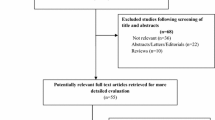Abstract
In economic evaluation of healthcare programmes both QOL and productivity of patients are aspects to be studied. Normally, the former is part of the measurement of the effectiveness of the programme and the latter is part of the measurement of its costs. In this paper we highlight the relationship between QOL and productivity. Two aspects are discussed: (i) the relationship between perceived productivity and health-state valuations; and (ii) the observed relationship between productivity and QOL.
The first aspect relates to the fact that in health-state valuations, respondents may consider income changes and ability to work. While this may have important methodological and practical implications, little empirical evidence exists in this area. The second aspect relates to the fact that the observed productivity of individuals is expected to be related to their health-related QOL. Worse health states are expected to be associated with lower productivity. Again, empirical investigation is lacking; however, this relationship may prove important, for instance in modelling productivity costs with use of information on QOL. This paper explores these relationships between productivity and QOL to stimulate debate and research in this area.



Similar content being viewed by others
Notes
Note that it is also possible that persons stay in a state of reduced productivity or are absent permanently. Furthermore, there may be relapses (e.g. persons who had returned to work but subsequently have to stay at home again because the level of impairment becomes higher again), which are not denoted in the figure for the sake of clarity.
References
Brouwer WBF, Koopmanschap MA, Rutten FFH. Patient and informal caregiver time in cost-effectiveness analysis: a response to recommendations of the US Panel. Int J Technol Assess Health Care 1998; 14: 505–13
Brouwer WBF, Koopmanschap MA, Rutten FFH. Productivity costs without absence: measurement validation and empirical evidence. Health Policy 1999; 48: 13–27
Lerner D, Reed JI, Massarotti E, et al. The work limitations questionnaire’s validity and reliability among patients with osteoarthritis. J Clin Epidemiol 2002; 55 (2): 197–208
Osterhaus IT, Gutterman DL, Plachetka JR. Health care resource and lost labor costs of migraine headache in the US. Pharmacoeconomics 1992; 2 (1): 67–76
Roijen L, van Essink-Bot L, Koopmanschap MA, et al. Societal perspective on the burden of migraine in the Netherlands. Pharmacoeconomics 1995; 7 (2): 170–9
Brouwer WBF, van Exel NJA, Koopmanschap MA, et al. Productivity losses before and after absence: as important as common? Health Policy 2002; 61 (2): 173–87
Severens JL, Laheij RJF, Jansen JBM, et al. Estimating the cost of lost productivity in dyspepsia. Aliment Pharmacol Ther 1998; 12: 919–23
Sculpher M. The role of productivity costs in economic evaluation. In: Drummond MF, McGuire A, editors. Economic evaluation in health care: merging theory with practice. New York: Oxford University Press, 2001: 112
Brouwer WBF, Koopmanschap MA, Rutten FFH. Productivity costs measurement through quality of life? A response to the recommendations of the US Panel. Health Econ 1997; 6: 253–9
Brouwer WBF, Koopmanschap MA, Rutten FFH. Productivity costs in cost-effectiveness analysis: numerator or denominator: a further discussion. Health Econ 1997; 6: 511–4
Johannesson M. Avoiding double-counting in pharmacoeconomic studies. Pharmacoeconomics 1997; 11 (5): 385–8
Russell LB. Is prevention better than cure? Washington, DC: The Brookings Institution, 1986
Koopmanschap MA, van Ineveld BM. Towards a new approach for estimating indirect costs of disease. Soc Sci Med 1992; 34: 1005–10
Koopmanschap MA, Rutten FFH, van Ineveld BM, et al. The friction cost method for measuring indirect costs of disease. J Health Econ 1995; 14: 171–89
Koopmanschap MA, Brouwer WBF. Controversial costs in guidelines. In: Pinto JL, Lopez-Casasnovas G, Ortun V, editors. Economic evaluation: from theory to practice. Barcelona: Springer, 2001: 129–43
Gold MR, Siegel JE, Russell LB, et al., editors. Cost-effectiveness in health and medicine. Oxford: Oxford University Press, 1996
Johannesson M, Meltzer D. Some reflections on cost-effectiveness analysis. Health Econ 1998; 7: 1–7
Meltzer D, Johannesson M. Inconsistencies in the ’societal perspective’ on costs of the panel on cost-effectiveness in health and medicine. Med Decis Making 1999; 19 (4): 371–7
Weinstein MC, Siegel JE, Garber AM, et al. Productivity costs, time costs and health related quality of life: a response to the Erasmus Group. Health Econ 1997; 6: 505–10
Sculpher MJ, O’Brien BJ. Income effects of reduced health and health effects of reduced income: implications for health-state valuations. Med Dee Making 2000; 20 (2): 207–15
Brouwer WBF, Rutten FFH. The missing link: on the line between C and E. Health Econ 2003; 12 (8): 629–36
Meltzer DO, Weckerle CE, Chang LM. Do people consider financial effects in answering quality of life questions? Med Decis Making 1999; 19: 517
Sendi P, Brouwer WBF. Is silence golden? A test of the incorporation of the effects of ill-health on income and leisure in health state valuations. Health Econ. In press
Brouwer WBF. The relationship between productivity costs and quality of life: some reflections and implications for measurement. Quality of Life Workshop; 2000 Sep 20, Leicester
Lamers L, Meerding WJ, Severens H, et al. The relationship between productivity and health related quality of life: an empirical exploration in persons with low back pain. Qual Life Res. In press
Acknowledgements
The funding of the Dutch Council for Health Care research (grant number 945-10-045) is gratefully acknowledged. Moreover, we thank Lex Burdorf, Karin Jacobs-Tacken, Marc Koopmanschap and two anonymous reviewers for their useful comments on earlier drafts of this paper. The authors have no conflicts of interest directly relevant to the content of this review.
Author information
Authors and Affiliations
Corresponding author
Rights and permissions
About this article
Cite this article
Brouwer, W.B.F., Meerding, WJ., Lamers, L.M. et al. The relationship between productivity and health-related QOL. Pharmacoeconomics 23, 209–218 (2005). https://doi.org/10.2165/00019053-200523030-00002
Published:
Issue Date:
DOI: https://doi.org/10.2165/00019053-200523030-00002



